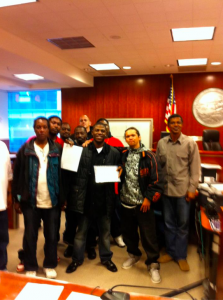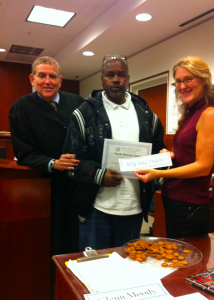 Judge Kevin Burke, president of the American Judge’s Association, recently wrote a blog describing “the closing of the highly successful San Francisco Parole Reentry Court”. He wrote his blog, “San Francisco Reentry Court: May it Rest in Peace”, after reading a New York Times article describing the closing of the Reentry Court (see “Parole and Probation Courts in San Francisco are Closing After Budget Cuts” ). Judge Burke commenting on that New York Times article, wrote, “The story speaks volumes about two things: (1) budget cuts to courts have real consequences and (2) there are emerging new ways that courts can reduce recidivism.
Judge Kevin Burke, president of the American Judge’s Association, recently wrote a blog describing “the closing of the highly successful San Francisco Parole Reentry Court”. He wrote his blog, “San Francisco Reentry Court: May it Rest in Peace”, after reading a New York Times article describing the closing of the Reentry Court (see “Parole and Probation Courts in San Francisco are Closing After Budget Cuts” ). Judge Burke commenting on that New York Times article, wrote, “The story speaks volumes about two things: (1) budget cuts to courts have real consequences and (2) there are emerging new ways that courts can reduce recidivism.
Let me speak to Judge Burke’s first point. In times of adversity, it is the problem-solving courts that are the first victims of cost-cutting. The argument, of course, is that the programs cost too much in resources and staffing. It’s an argument that has been debunked by numerous studies done on drug courts and other problem solving courts over the last twenty years (A recent national study by the Urban Institute found that for every $1 invested in Drug Court, taxpayers save as much as $3.36 in avoided criminal justice costs alone. When considering other cost offsets such as savings from reduced victimization and health care service utilization, studies have shown benefits range up to $12 for every $1 invested). It simply is no longer acceptable to cut one of the most beneficial, but least political aspect of the courts. Resources must be found to sustain and expand these critical programs.
Some argue that the case for reentry courts is less than compelling. That dealing with parolees and ex-prisoners is an executive and not a judicial function, and that they are best left to the jurisdiction of Corrections and Parole. But courts in California, as well as other states are getting into the prisoner supervison business,whether they like it or not. In California, legislation took effect last October, requiring county courts to sentence offenders (who would have previously been sent to prison) to county jail and then to supervise them in the community. States like California ( and those that will surely follow), now have the jurisdiction and the responsibility to rehabilitate and supervise the high-risk offender that are under their jurisdiction.
As San Francisco’s Reentry Court Judge over its fifteen month demonstration period, I have my own perspective on these issue. We recognized the danger and attempted to limit court costs. We reduced staffing to a bare minimum, using a retired part-time judge and clerk, and doing without a district attorney and a reporter (except when requested by defense counsel). We held drug relapse, cogntive therapy and other program sessions in the court building and in many case, the closed courtroom itself to reduce administrative costs ( “A minimalist reentry courts for recessionary times”). After our best efforts at reducing costs, we were still closed when the budget was cut.
What’s is of greatest interest, is Judge Burke’s second point; “there are emerging new ways that courts can reduce recidivism”. The success of the San Francisco Parole Reentry court has been documented (One Year San Francisco Reentry Court Report Card). The real success of reentry courts lies not in their cost savings, but in their potential for salvaging damaged lives, restoring them to their communities and families, and preventing their future “return to prison”. The thing to keep in mind is that there are new ways for the court to deal with the returning prison offender, and that we have a moral obligation to investigate, develop, implement, and evaluate those court-based alternatives, as we have so successfully done in the past for drug courts.




